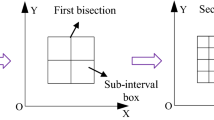Abstract
In this paper, a novel numerical approach is proposed for workspace determination of parallel mechanisms. Compared with the classical numerical approaches, this presented approach discretizes both location and orientation of the mechanism simultaneously, not only one of the two. This technique makes the presented numerical approach applicable in determining almost all types of workspaces, while traditional numerical approaches are only applicable in determining the constant orientation workspace and orientation workspace. The presented approach and its steps to determine the inclusive orientation workspace and total orientation workspace are described in detail. A lower-mobility parallel mechanism and a six-degrees-of-freedom Stewart platform are set as examples, the workspaces of these mechanisms are estimated and visualized by the proposed numerical approach. Furthermore, the efficiency of the presented approach is discussed. The examples show that the presented approach is applicable in determining the inclusive orientation workspace and total orientation workspace of parallel mechanisms with high efficiency.
Similar content being viewed by others
References
Y. Lu et al., Kinematics/statics analysis of a novel serialparallel robotic arm with hand, Journal of Mechanical Science and Technology, 29 (10) (2015) 4407–4416.
C. Zhu et al., Dynamic characteristic parameters identification analysis of a parallel manipulator with flexible links, Journal of Mechanical Science and Technology, 28 (12) (2014) 4833–4840.
D. Glozman and M. Shoham, Novel 6-DOF parallel manipulator with large workspace, Robotica, 27 (6) (2009) 891–895.
Q. Yang, H. Wang and S. Li, Determination of the maximal singularity-free zone in the whole workspace of 3-RRR planar parallel mechanism, 5th Annual IEEE International Conference on CYBER Technology in Automation, Control, and Intelligent Systems, Shenyang, China (2015) 59–64.
L. W. Tsai and S. Joshi, Comparison study of architectures of four 3 degree-of-freedom translational parallel manipulators, Proceedings of the 2001 IEEE International Conference on Robotics and Automation (ICRA), Seoul, Korea (2001) 1283–1288.
S. R. Babu, V. R. Raju and K. Ramji, Design optimization of 3PRS parallel manipulator using global performance indices, Journal of Mechanical Science and Technology, 30 (9) (2016) 4325–4335.
S. Bai, Optimum design of spherical parallel manipulators for a prescribed workspace, Mechanism and Machine Theory, 45 (2) (2010) 200–211.
B. He et al., Workspace analysis of a novel underactuated robot wrist based on virtual prototyping, The International Journal of Advanced Manufacturing Technology, 72 (1-4) (2014) 531–541.
J. P. Merlet, Parallel robots, Second Ed., Springer Science & Business Media, Massachusetts, USA (2006) 213–215.
C. Gianni, O. Erika and C. Marco, A fairly general algorithm to evaluate workspace characteristics of serial and parallel manipulators, Mechanics Based Design of Structures & Machine, 36 (1) (2008) 14–33.
J. Fu and F. Gao, Optimal design of a 3-Leg 6-DOF parallel manipulator for a specific workspace, Chinese Journal of Mechanical Engineering (2016) 1–10.
X. Fang et al., Optimization of a crossbar parallel machine tool based on workspace and dexterity, Journal of Mechanical Science and Technology, 29 (8) (2015) 3297–3307.
X. Chen et al., Workspace and statics analysis of 4-UPSUPU parallel coordinate measuring machine, Measurement, 55 (2014) 402–407.
M. Badescu and C. Mavroidis, Workspace optimization of 3-legged UPU and UPS parallel platforms with joint constraints, Journal of Mechanical Design, 126 (2) (2004) 291–300.
A. Kosinska, M. Galicki and K. Kedzior, Designing and optimization of parameters of Delta-4 parallel manipulator for a given workspace, Journal of Robotic Systems, 20 (9) (2003) 539–548.
G. S. Hu, Current status of workspace in parallel manipulator research, Electronics Instrumentation Customer, 11 (6) (2004) 1–3.
A. M. Hay and J. A. Snyman, Optimization of a planar tendon-driven parallel manipulator for a maximal dextrous workspace, Engineering Optimization, 37 (3) (2005) 217–236.
L. J. Du Plessis and J. A. Snyman, A numerical method for the determination of dextrous workspaces of Gough–Stewart platforms, International Journal for Numerical Methods in Engineering, 52 (4) (2001) 345–369.
M. Toz and S. Kucuk, Dexterous workspace optimization of an asymmetric six-degree of freedom Stewart–Gough platform type manipulator, Robotics and Autonomous Systems, 61 (12) (2013) 1516–1528.
J. C. Niu, F. Yang and Y. Li, Multi-dimensional vibration isolation based on metamorphic parallel mechanism, Journal of Vibration and Shock, 33 (7) (2014) 206–209.
F. Yang, Research on multi-dim vibration isolating device based on metamorphic parallel mechanism, Master Thesis, Shandong University, China (2013).
Author information
Authors and Affiliations
Corresponding author
Additional information
Recommended by Associate Editor Kyoungchul Kong
Yiqun Zhou received his bachelor’s degree in Mechanical Engineering from Wuhan University in 2014. At present, he is a master degree candidate at Shandong University. His research interests include robotic and control.
Junchuan Niu received his Ph.D. in Mechanical Engineering from Shandong University in 2003 and worked as a Postdoctoral Fellow at Imperial College London from 2009 to 2010. He has been a Professor of Shandong University since 2010. His research interests include robotics, vibration control and energy finite element analysis.
Rights and permissions
About this article
Cite this article
Zhou, Y., Niu, J., Liu, Z. et al. A novel numerical approach for workspace determination of parallel mechanisms. J Mech Sci Technol 31, 3005–3015 (2017). https://doi.org/10.1007/s12206-017-0544-z
Received:
Revised:
Accepted:
Published:
Issue Date:
DOI: https://doi.org/10.1007/s12206-017-0544-z




